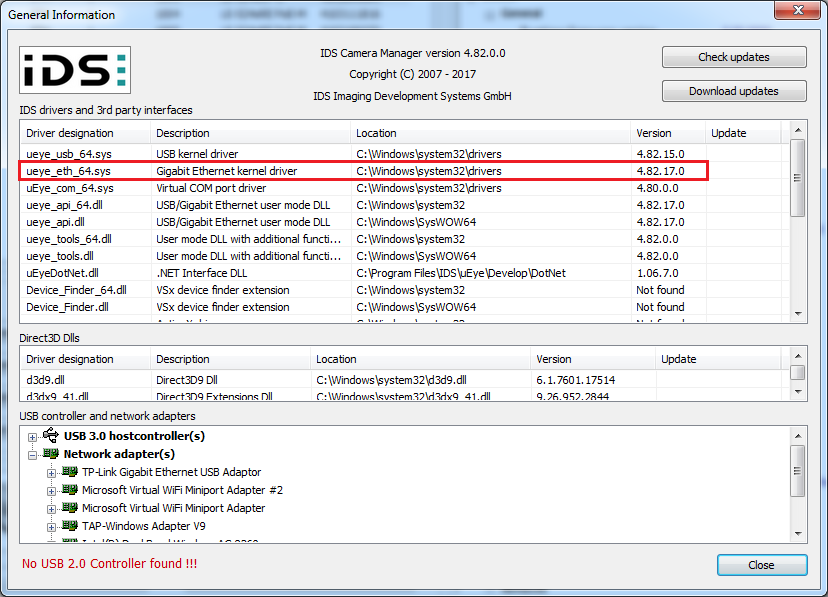Opening a Device¶
Open NxView from your computer’s start menu.
After the program has launched you should see the camera list of NxView as in the image below. The list contains all currently available cameras, including File Cameras (
 ) and Virtual Cameras (
) and Virtual Cameras ( ).
).
Hint
Have a look on our guides on the usage of File Cameras and Virtual Cameras.

If your device is shown as Available and without any warnings, just double click on it. You can open multiple devices by first selecting the devices and then click on the Open button in the upper right corner of the window.
Trouble-Shooting:
- My Device Is Not Listed
- My Device Shows a Warning
Your device is now open and you can see a you with a color coded depth image of the scene like it is shown in the image below.
Trouble-Shooting:
- The 3D Data is Bad
- The MTU is Low

Now that your camera is up and running you can have a look at the rest of our guides for more advanced topics.
Hint
Need Support?
If you followed all the other troubleshooting guidelines and NxView still cannot find your camera, check out the Ensenso Community or contact the IDS support.
Trouble-Shooting¶
My Device Is Not Listed¶
If NxView cannot find your camera, there is probably a problem with your network configuration. The Network Wizard will help you to set everything up correctly.
When NxView still cannot find your camera after you ran the Network Wizard, you should check the following troubleshooting guides:
Does the device have power? Does its LED light up?
For N-series cameras: Does the network cable provide power through PoE?
Does the power supply provide enough power according to the specifications?
Did you use the Network Wizard to set up the IP configuration of your network adapter and camera?
Is the camera connected through other network devices (e.g. a switch)? Did you try to connect it directly to the PC?
For uEye based cameras:
Did you install the correct uEye driver?
Is the uEye daemon active?
You can check both points in the IDS Camera Manager. The driver version can be found after clicking the General Information button.
My Device Shows a Warning¶
If your camera is listed but shows a warning, the following troubleshooting information will help you resolve this warning:
If you assembled an X-series device yourself, you will first need to pair the projector with two monocular cameras. Select the projector and then click the Calibrate... button to start the calibration wizard. After the calibration procedure the X-series stereo system behaves just like an N-series camera.
Note
XR-series cameras will automatically pair with the attached cameras when powered on.
If an Ethernet camera has an invalid IP configuration for the network adapter that it is connected to, you will get a warning and cannot open the camera. The easiest way to get a valid IP configuration is to use the Network Wizard or, if your camera is already listed, you can simply press the Network Wizard button in the side panel. You can also set a manual IP configuration by selecting the camera and clicking the IP Config... button.
If the configuration succeeds the camera will be listed as Available.
If a camera has an outdated firmware, the Firmware Update button will appear next to it. Clicking it will automatically upload the required firmware which was shipped with the EnsensoSDK or the installed uEye driver. For XR-series cameras you will be prompted to download the corresponding firmware file if it hasn’t been downloaded locally before.
Note
When uploading a new firmware onto the camera please make sure that the camera is safely connected to power and network so that you don’t interrupt the upload process. XR-series cameras need to be power cycled after the upgrade is finished.
The 3D Data is Bad¶
If you cannot see meaningful 3D data, please make sure that the distance between the camera and the scene objects is appropriate for your camera model. You might now also want to take a look at the camera setup considerations and Parameter Adjustment.
Changes in temperature and forces from mounting the camera can also change the camera’s internal geometry and lead to an incorrect calibration. Check the calibration as described in this guide.
The MTU is Low¶
If you are getting warned about a low MTU please see the section Maximum Transmission Unit (MTU) in the Network Performance guide for help.

